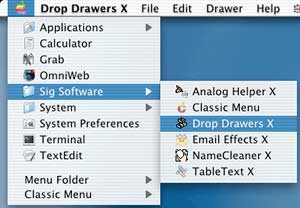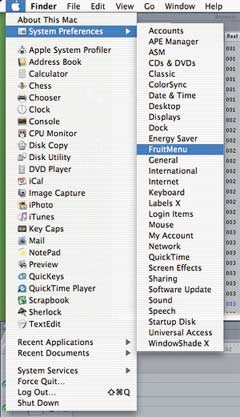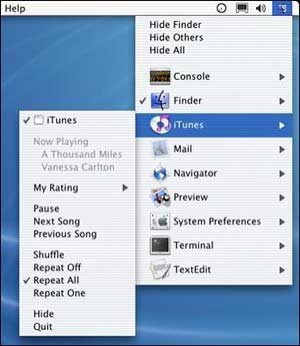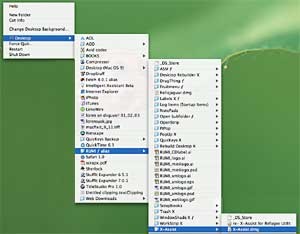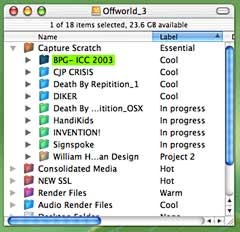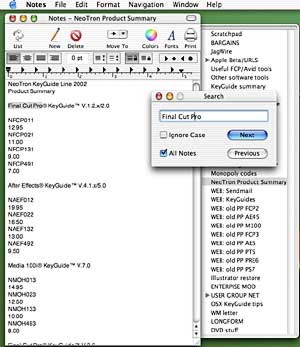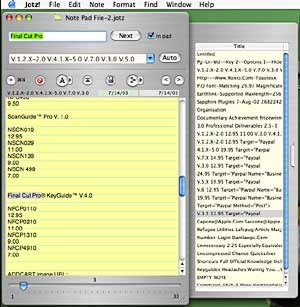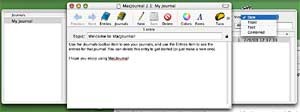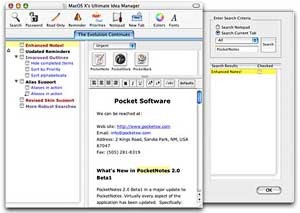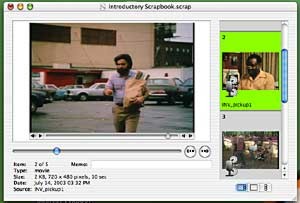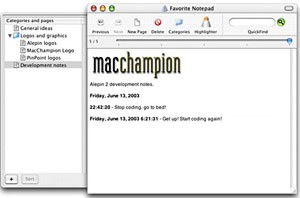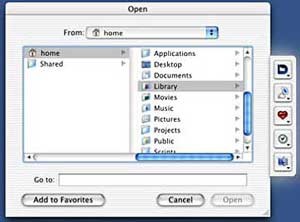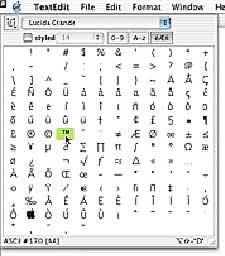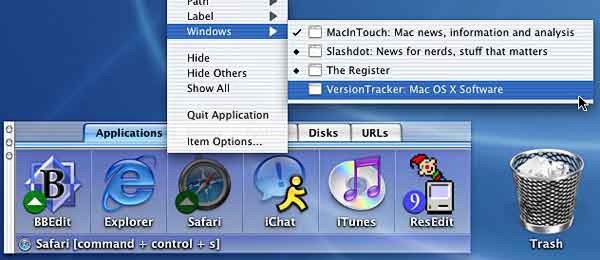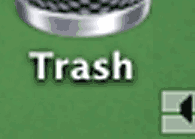
White Paper - Tools for OS X August 4, 2003
The Refugee Utilities for the MacOSX Interface
You can restore virtually your entire OS9 look-and-feel user
experience to your OSX environment. You do not have to live
like a refugee in the new world. You can take back your Mac.
We're in 2003 and according to Apple, the transition to MacOSX is well over half complete. After this year Macs which boot into OS9 will be hard to find -- it's interesting to see some retailers and mail order outlets explicitly advertising this capability-- it's becoming a distinct product offering. And while some vendors will likely include bundled OS9 versions of software, these won't be supported much longer. And don't rely on the "Classic" environment of OSX to run old software either: it's a kluge, a stopgap, something like a flatlander trying to exist in 3D space. So what's an OS-Niner to do?
I'm recalling one of my younger brothers, who, at age three was placed for the first time in a brand new filled sandbox. He went into a conniption; he couldn't handle it; there was nowhere solid to stand. Then I watched Dad simply brush away sand to reveal the wooden floor -- just a patch -- and suddenly all was well; the tyke sat and started playing, and soon sand covered the floor again.
The first time I played with it, I felt like an utter refugee in the very full sandbox of MacOSX, and I needed a familiar patch. Very little on my screen was where I needed it to be or behaved the way I expected, or looked the same. Muscle memory, motor memory, body mapping, imprinting, kinesthetics-- call it anything you like. These terms define skill and routine, acquired through years of experience using a system and programs within it in certain personal and productive ways, and mine were rudely disrupted.
The Macintosh more than any other computer system has over the years powerfully leveraged the user's need to find consistency and predictability while allowing a lot of customization. This was codified in the early 80's though an amazing, farsighted published set of design and interface canons for software engineers called the Apple Human Interface Guidelines. Most of the AHIG's have not gone out of date. But many of them have been swept away in MacOSX and I was experiencing PISD -- Phantom Interface Syndrome.
A distinction must be made between the Refugee Utilities collection and references such as Scott Kelby's handsome new book "The MacOSX Conversion Kit" (Peachpit, 2003). We both promote a smooth switch to OSX, no issue there. Kelby's book will take you by the hand and show you with crystal clarity how Apple wants you to do things in OSX compared to the way you did things in OS9-- and regrettably the book's authors occasionally misinform you about features and functions that are "gone, gone, gone," when in fact-- as you will see here-- they are easily brought back, back, back. RUMI places user need and body history first.
Interface, Splinterface
The RUMI collection facilitates a forward migration to OSX which includes the way you want to do things in OSX based on your past use of the tool, not the way Apple's ex-Next interface design wants you to work-- although OSX has some wonderful new stuff, and is certainly helping transition Windows users to Mac, and we're darned glad to have them over! Even if you like the entire ex-Next design, there's work to do. In Jaguar as in earlier vesions, Apple needs to fix little things like the New Folder shifted window bug-- that never happened in OS9-- which I feel was coded to drive me insane. The Columns View file delete behavior is bizarre-- see Deleting Trash, below. And someday soon OSX apps will be just as fast as OS9 apps on the same machine. (Of course leaving OS9 out of those machines is one way to avoid comparisons, eh? Eh?) But even when OS speed issues are eventually solved, and you know they will be, body memory issues remain.
Those tool users-- such as those who started using Macs in OSX and have nothing special invested in past use-- and who feel this whole concept is some nitpicky fractious fuddy duddy tempest in a teapot should first check out some cool features from OS9 they're missing. Those who resigned to losing them, look again! Your Mac is back.
I have always felt that, to cope with change, help create it. And, as it turns out, a lot of third party developers are helping-- out of their own PISD and understanding of their installed base-- as are a lot of reader/users feeling the same pain I do.
Pain expressed in epithets such as, "where's my ?¿$#@! Trash Can?"
Hail, RUMI
In 2001, I started a MacFixit forum discussion/news thread, at www.macfixit.com >Forums> Mac OS X Troubleshooting > Utilities Mac OS X, entitled "Collected Refugee Utilities Here!" which continues growing to this day. I am grateful to MacFixit, founder Ted Landau, and forum moderators Ilene Hoffman and P.A.M. Borys, for providing the venue, and especially to all the thread participants who have contributed recommendations, ratings and "re-feature requests" for their favorite needs. Distilled from that thread are periodic updates to the RUMI article you're reading here at LAFCPUG. In the process, we are supporting and revitalizing a small and talented Mac shareware development community who are also identified and celebrated both in the thread and here. Website links to developer sites are most often updated there, when necessary. Errors of fact and fancy published here are all mine.
Testing and Tog Points
Installation and testing of the utilities was done on a two-year old Quicksilver G4, which makes a good realworld testbed. Because I use Final Cut Pro and other media creation products regularly, I test with such programs running concurrently. Each selected utility recaptures some important element of the classic Mac interface you might be missing in OSX. Some are still "betatest" quality but show promise, some are finished and trouble free. Some are free, some cost a pittance in one-time shareware fees-- and many vendors offer free updates, because registered users are truly precious. One or two have been quickly un-installed, and in fact, booting back into OS9 has proven the easiest way to dump one or two stubborn apps which misbehave! (We don't talk much about these. If you can't say anything nice...) I describe them as I experienced them at the time, fully aware that evaluation is a moving target.
The rating system is based upon "Tog" points, from 1 to 5, with 5 representing excellence in a) Classic feature recapture, b) product design and useful OSX enhancement, c) overall behavior and d) price. Price figures here because we remember most interface features and functions listed here were free in OS9 and earlier, so we're gauging the "VQ--venality quotient" in the given price-- fully aware that software authors must make a living. The Tog is named after legendary former AHIG guru Bruce Tognazzini, who still rails against unfriendly interface design at www.asktog.com, a wonderful and rich resource for all kinds of information designers. (Check out his reasoned critique of the Dock. It's the RUMI mission statement.) Tog points are now graphically represented as actual Tog heads. Because we're only able to slice Bruce's head into quarters-- the score becomes less distinct if we slice him further-- we're streamlining the rating granularity from deci-Togs up to quarter-Togs. Bruce supports the RUMI concept, although the ratings are neither his nor entirely mine, they are democratically averaged from user votes on the MacFixit RUMI thread, reviews of latest available versions from versiontracker.com, spirited from user reports I get, and other sources. And be aware, most developers are quick to improve their work if they know users are interested. Stay in touch with them.
So let the worldwide RUMI list begin! Take as little or as much as you need to re-establish your comfort level in the new world. Mac is worth it.
Desktop operations
Rebuild Desktop X www.SubRosaSoft.com (4.25 togs)

Oh, this is great. Apple has retained Command-Option-P-R to zap corrupted Parameter RAM settings, and even saved holding down Shift on restart to boot into "Safe Mode"-- suppressing extensions. But no Command-Option to restart/rebuild an ailing desktop? Worry not. Now you can rebuild your desktop in OSX. The actual rebuilding task is pretty quick, and then forces a restart-- backwards from the original process. OSX builds its "Desktop files" on the fly, so there is no actual "progress bar" possible. But DRX cleans caches, resets the binding between most apps, their icons, and their documents... more or less the same effect as DR in OS9, according to New Zealand developer Marko Kostyrko.If you're really obsessive, use QuicKeys (covered below) and map it to Command-Option-R to sort of simulate that fabulous "time to rebuild my desktop" feeling. Have the shortcut launch Rebuild Desktop X and it'll do a restart. (You can take your hands off the keys now, it's all done!) Feels like DRX combined with Repair Permissions recaptures a full desktop rebuild. For a real DR restoration, wouldn't it be great if...? Find DRX on the SubRosa site under the Freeware category, and give a looksee to their other utilities.
Deleting Trash www.apple.com (3.25 togs)
Let me allay two potential Refugee-like issues in OSX which Apple adroitly dodged. First, as in OS9, you can still move selected stuff to the Trash with Command-Delete, and empty your trash from the keyboard with Command-Shift-Delete.

Just be careful in using these commands in OSX Columns view-- if you repeat Command-Delete without looking, reasonably expecting you'll delete the next file down in the column you're in-- forget it: you missed the new "jumpback" feature. You'll have deleted the containing folder in the previous column! You're wondering where that Final Cut Pro media folder went after you thought you deleted two little files inside it? Whoa, indeed!
Shutdown from the keyboard www.apple.com (4.25 togs)
Second, the 4-choice Shutdown dialog is still available-- but where's the missing keyboard Power button which invokes it? Well, Steve and his designer Jonathan Ive decided you should instead 1) poke the Power button on your shiny new flatpanel screen to light up your Mac, or 2) give a second tap to send it to sleep, or 3) with a sustained press to shut it down. Not bad.

But what about the convenient choice dialog which also offers Restart? Using new USB Apple keyboards under OS9 as well as OSX, you hold CONTROL and tap the Media Eject key to bring back the "Are you sure?" dialog containing the classic "Restart-Sleep-Cancel-Shutdown" button choices-- with their equivalent keyboard commands: R, S, Command-period or just Return for Shutdown. The dialog never really left the sandbox, it's just buried under elegance.
And for everything else which might annoy you in OSX, we have solutions from around the globe most all are Jaguar-tested.
What's on the Menu?
The foremost third-party Refugee Utilities are menu restorations. From this you can discern that (in case you didn't know by now) the Apple menu as you knew it has gone away.
Classic Menu www.sigsoftware.com (4.50 togs)
Classic Menu layers a Classic multicolored Apple icon over your actual pale blue Apple menu icon. This may confuse at first. It floats over it-- and you can still access the real one with a second click (should you wish to customize your Dock) but it also allows you to stuff the menu with all the goodies you'd traditionally expect to find there-- even disks and volumes and servers, by filling your "Classic Menu Items" folder, stored within UserName>Library>Preferences folder. Does it look much different than your ordinary classic Apple menu list? It was the first such shareware utility released for OSX and like its developer remains in play as a well-behaved restoration.

If you truly bleed six colors, voila. Stuff the menu with all the things you're used to seeing there.
FruitMenu (www.unsanity.com (4.50 togs)
FruitMenu, which really does replace the system Apple icon-- although not fruit-striped-- is a handsome shareware utility packed with extras. You can integrate all the existing Apple menu functions (such as access to your Dock preferences, should you need them) but as you can see in the figure I've managed to restore most of the other things I need here from OS9. Your familiar accessories and the like go into FruitMenu's handy "FruitMenu Items" folder, which is installed in your UserName>Library folder. If you're really obsessive, do what I did, load the folder with aliases to the actual accessories and rename them. You see "Chooser" in the menu but it'll load the new Print Center to choose a printer. You see Notepad and Scrapbook here, but they point to new products which restore those capabilities, listed below. Hey, it's a comfort issue.

Any application which holds up under more than two OSX upgrades automatically gains a quarter-Tog, and FruitMenu qualifies. I had an interesting issue when I tried sorting my FM Items window to reorganize the menu-- I used the same company's Labels X (discussed below) to sort on color. It worked in the Items window but the sort did not transfer to the actual menu! There are also reports of menu conflict between FM and side components of Final Cut Pro 4 such as LiveType. But Unsanity remains committed to its "haxie" products, regularly issues updates, and appears to be well on its way to becoming one of the "mini-majors" in OSX software development. This is commercial software with a free 15-day evaluation.
FruitMenu returns your comfortable Apple menu in OSX, while adhering to Aqua color scheme.
Application Switcher Menu ( www.vercruesse.de/software) (4.50 togs)
Remember the handy drop-down menu which listed your loaded applications on the upper right menubar? It's baaack! ASM comes from Frank Vercreusse, a young programmer living in Leipzig, Germany. Although it is an add-on "menu extra" in OSX terminology, it's also absolutely trouble-free to install and use. ASM does just what you'd expect from OS9: run your mouse to the upper right screen and down drops a menu list of all your open applications. Select from any in the list to switch from one to another just like in the old days. You'll feel PISD subsiding quickly. ASM has been absolutely free for far too long, and Frank wants to support future development of this and other OSX products, and will be levying a reasonable shareware fee rather than depending upon PayPal donations as in the past. I've used it now for 18 months, through three OSX upgrades. Not a hint of rudeness. He's out of school. Give him the business! Well-deserved.

Application Switcher should never have left the party. It's back, with treats.
X-Assist http://members.ozemail.com.au/~pli/x-assist (4.50 togs)
This is Australian Peter Li's competing application switcher menu, also freeware. That alone is great, but it really shines in its contextual menu support for unlimited levels of submenus (the usual is five)-- which pops up at mouse origin. With an objective-C plug-in architecture integrated, the product also allows other developers to contribute features, so expect X-Assist to grow. Some users may find X-assist a really good solution if they desire to leave the OSX Apple menu as they find it, and like ASM this utility seems very polite in mixed company. It's free!

X-Assist contextual menus let you go on almost forever, beginning at the point of your mouse.
Finder restorations
OS9 and earlier users invested a lot of time in learning and imprinting behaviors that really worked well in the Mac Finder.
Spring Loaded Folders www.apple.com (5.0 togs)
Apple itself deserves high credit for faithfully recapturing one OS behavior many users really love: the intuitive spring-loaded folders action is restored in the 10.2 "Jaguar" release of OSX. Restoration is perfect and as before, the folder-open delay is adjustable. In case you've never used it, just drag a file over a disk icon within any MacOS desktop from 7.x up through 9.x. Poof! Keep the mouse button down: the disk window opens and allows you to select another folder and further "drill down" to the destination you want, where you release to deposit the file. Simple, elegant, predictable. No dialog boxes or copy commands. You do three things at once and everything snaps closed again (spring-loaded, get it?) without littering the desktop with opened windows. Since one of OSX's newest innovations is an awkward Windows-File-Manager-like Columns view contrivance which doesn't cheer everybody, SLF's are a welcome "re-enhancement."

Labels www.apple.com Rating withheld until release
The ability to color-code files in icon or list view is restored (applause) again by Apple in the 10.3 "Panther" release of OSX. One of our star shareware developers, Unsanity, offers an alternative for those if you're using earlier versions of OSX. It's covered below. Hopefully, labels in OSX will inherit your custom labeling in OS9 or from OSX versions utilizing Labels X.
Labels X www.unsanity.com (4.0 togs)
Were you missing this? Relax, it's back. A good-looking restoration of a popular organizing function, allowing icon and list views to be colored and custom-commented for sorting. Labels X even inherits your icon labeling from OS9! Exactly the kind of transitional tool needed for labeling, and you can change the color set as well as the comments they represent. During one contextual menu-driven color assignment I got a crash; but it has behaved since-- although why doesn't my FruitMenu Items sort on labels? Commercial software with free 15-day evaluation.

The wonderful world of sortable color is back with Labels X.
WindowShade X www.unsanity.com (4.50 togs)
Unsanity swings again, with another home run right through the window. This restores the delightful ability to zip a work window not into the Dock, but into itself-- right up into its title bar to see anything behind it, while keeping it fully "live." There's also an option to remove the drop shadows on windows cast by OSX's Quartz display engine. Newest features include "Minimize in Place" function, which turns a window into a nearby postage stamp. Some users report a slowdown after this utility is installed, but mine on a G4 Dual-800 tower remains very well-behaved. My only issue with it is a mini-delay in the ability to restore a window-- wait half a second before double-clicking again. This has never crashed on me. Commercial software with free 15-day evaluation.

Users with limited screen space lived by WindowShade in OS9. Here you can also make Finder windows transparent.
OpenStrip joe@strout.net (.50 togs just for historical effort)
Joe Strout's project was an open-source effort in 2000 to build a true, classic style modular Control Strip specially for OSX, planned to include a software development kit for Openstrip module authors. If a developer is interested in carrying on the initial work, Joe might be helpful; he feels current MacOSX has largely preempted the need for it. (But that was before the Refugee Utilities became a force for less change, more function.)
PopUp X www.madoverlord.com Rating withheld until new release.
Pop-Up Tabbed Windows is a personal request by Bruce Tognazzini, who like many of us used it constantly under OS9. Author Robert Woodhead was also annoyed by the absence of TPW's in OSX-- the ability to drag any Finder window to the bottom of the screen to create a tab which pop ups into the full window when needed. Versions of PopUpX aren't working properly in Jaguar. Robert was responsive to recent contact and he's tackling it when time permits, but be aware, it's still in beta, and PopUpX still differs in operation from the original function, in that you have to drag aliases of those windows you want tabbed not to a screen edge but into the PopUpX window. You then launch the utility and poof! Your poppable border window tabs appear, alphabetically. Freeware, in progress, and let's be thankful to Robert for the work. Let him know.
Drop Drawers www.sigsoftware.com (4.50 togs)
Hold everything! That's the idea here. The closest extant implementation of bordering window tabs which open up and offer multi-data storage space is Sig's neat Drop Drawers, so we now include it. This was also an OS9 product, and it was pretty neat to use then too, but then-- we already had working Tabbed Popup Windows. DD moves beyond the orignal-- it will also remind you a bit of Simpletext, Notepad, a bit of Scrapbook, a bit of Launcher. When you boot it, a bunch of useful tabs are prebuilt and deposited for you. Move tabs along any desired edge of your workspace with popout drawers containing everything from live web URL's to QT clips, thumbnails and images, email addresses, text snippets, old and new formats of sounds. When I dragged a movie clip from QuickTime Player to a DD clip drawer and invoked Play Movie, it wouldn't play-- but it's still a cool way to store stills, which can be pasted elsewhere.

Michael Horton, chairman of LAFCPUG, loves Drop Drawers. Rumor has it he stores all his script sides from his multi-season appearances as Jessica's nephew Grady in "Murder She Wrote." He occasionally pops open a drawer to recite a scene, playing all the parts, forcing his family to listen and laugh on cue as he relives past glory. Only in Hollywood. DD hides easily via hotkey when not needed. Its developer (author of Classic Menu) has a history of commitment to the Mac. Offered as shareware.
DD adds the kinds of enhancements you'd expect from an OSX version of Tabbed Popup Windows.
Notepad and Scrapbook restorations
Apple still supplies many applications once thought of as Desk Accessories: Calculator, DVD Player, Key Caps, Stickies, etc. all hidden away in the Applications folder. They can all be aliased and brought into Classic or FruitMenu items windows. But somehow the lowly, ever present Note Pad and Scrapbook desk accessories got away. They're baaaaack! There are several OSX notepad replacements available, some of the best are free.
Notes http://ayanamichan.com/richard/notes (4.75 togs)
The freeware Notes by Richard Scheyer remains the all-round champ. It's what Apple would have done if all those former Next engineers were fed enough fruit to prioritize things like this. It uses a new OSX "drawer" action (actually a Next-style widget in Mac clothing) to access a list of notepad pages, which unlike the original can be named. Most important, talk about seamless transition; you can import your OS9 Note Pad file pages! You can drag-drop or drag-switch text entries in the list, rather like managing browser bookmarks. There's a decent Find function built in. You can import RTF text and pictures such as Tiff's, but there are now a couple of good Scrapbook replacements which do this and much more. I put Notes right into my Apple/FruitMenu --and I've renamed the alias to "Note Pad"-- where I've always put it. Still freeware. I feel restored here.

Notes from Richard Scheyer. Ah, the simple Mac conveniences are back-- on steroids!
Jotz www.thinkertons.com (4.50 togs)
Similar to Notes, with a notably richer feature set (and price tag), an emphasis on databasing, sorting, and with good printing layout capabilities. Its reminds me vaguely of QuickDex, but it is still largely a notepad, with a "Shuffler" drawer similar to Notes, which allows you to organize topics by dragging. Each page can be time and date-stamped. It sports a "Ruffler" drag-scroller which navigates the contents of a pad. It also works on Command-left-right arrow keys, just like the original. It imports classic Note Pad files as well. Very handsome look and implementation, with a choice of skins-- a worthy effort, and regularly updated by the developer, who offers it as shareware.

Note Pad deluxe. Jotz offers powerful databasing and print layout.
MacJournal http://homepage.mac.com/dschimpf ) (4.50 togs)
The DNA for notepads is amazingly mutable. You like sliding drawers? How about two? Dan Schimpf, a University of Michigan computer engineering student, won the first student competition of the 2002 Apple Design Awards with MacJournal, his spectacular double-winged Mac OSX diary. Developed by Schimpf as a calling card, it's a full-featured little item with two slide-out drawers, one for Journal chapters and the other for Topic lists which are automatically time and date stamped. This is an amazingly rich product. This too looks good in your ClassicMenu. Offered as freeware.

Drawers? We got drawers! A student exercise becomes a useful diary-oriented product.
PocketNotes www.pocketsw.com (4.25 togs)
Think the market space for notepads is getting crowded? And who among us decries choice? Pocket Software is a New Mexico based software company owned by Nicholas Gustilo, and his PocketNotes' special distinction is that it's also a simple yet powerful outliner and planner/event reminder. It also allows unlimited Undo's, storage of "live" URL's; allows you to re-skin it in a variety of looks, allows you to prioritize your notes; to search your notepads by priorities, tabs, other pads, or just plain text. And there's more. Offered as shareware, and the most expensive in the collection thus far, but the developer has been around for a while and offers goodlooking, useful products.

Take it to the time limit with PocketNotes, notetaker, event planner, alarm reminder.
ScrapX www.aqueoussoftware.com (4.75 togs)
This is not your daddy's Scrapbook, supporting little more than PICT or aging 3DMF graphic formats. ScrapX also supports BMP, GIF, JPEG, PICT, PNG, RTF, RTFD, TIFF, URL, plain text, movie, sound, and (classic) sound resource formats, including .mp4 and AAC. Also multi-page PDF's, QuickTime movie clips, even animated GIF's! You can even search on formats. "Unsupported" formats are stored even if it cannot display them. Just like the original, you can drag and drop an Illustrator file into a ScrapX window and it'll display the raw underlying Postscript. Copy and paste it into Notes, Jotz, or TextEdit to actually edit the text. Heavy Postscript designers find this useful. ScrapX is a fine scrapbook utility from Tim Kokesh, supported in English and French, with useful new enhancements to the old chestnut, such as an optional vertical-scrolling thumbnail preview, and the ability to see the same file in more than one format by clicking on its text description under the image window. Aqueous seems serious about feature restoration and improvement, even provides a table comparing classic and new products on the website. Offered as shareware.

Finally, the introduction of ScrapX for ex-OS9 packrats.
Alepin www.macchampion.com (4.50 togs)
Here's another powerful multi-format scrapbook restoration which is also available in English and French (obviously the only two languages needing scrapbook utilities!), supports the same large array of image formats as ScrapX, including QuickTime, although when I dragged in a QT file, the scaling behavior differed, and when I attempted to play it, I got a rude crash which didn't occur in ScrapX-- which played some of the clip, then stopped. Alepin is a good looking utility and is positioned to offer both Note Pad and Scrapbook capabilities, doing good service as both. Offered as shareware.

Another useful scrapbook, Alepin combines it with notepad functions.
Third Party Productivity Enhancements from OS9
While we generally limit the RUMI list to OS-derived restorations, there are a few popular add-ons which have transitioned to OSX and they're worth mentioning, for those suffering an unnecessary nostalgia attack-- or some useful functions they cannot find.
Default Folder X www.stclairsoft.com/DefaultFolderX (4.25 togs)
A favorite Open/Save dialog enhancer is back. Like the original it seems solid with navigation and find extras which ought to have been in the OS itself. DFX has a "memory" which presents the last folder you saved to, just like in the original. A real aggravation tamer.

Additional power for any Open/Save dialog from easy to use side buttons.
PopChar X www.macility.com/products/popcharx (4.25 togs)
The perfect complement to KeyCaps, this allows you to select arcane symbols from any font and get them quickly into your document. Just as in OS9, a teeny tiny little "P" square in the upper left corner of your screen is the access point, in any application. Works predictably.

Holy Daniel Jackson! That's where the Stargate symbols are hiding.
QuicKeys X2 www.cesoft.com (4.75 togs)
QuicKeys is really back! One of the most venerable Mac productivity enhancers (since 1987 and now available for Windows) this macro/shortcut utility saves the day when you're faced with boring, repetitive computer tasks or remapping key commands in Final Cut Pro 3 or earlier. Extremely valuable in aliasing OS keyboard control: for instance reworking of Finder commands such as Command-L back to Command-M for Make Alias; Command-Shift-N back to Command-N for New Folder, etc. Place QuicKeys in your "LogIn Items folder" to start it automatically when you boot. Works in deep background till you call it. Beyond aliasing, there's improved recording of real-time actions as sequences -- trigger it all from a single key command. Assign hotkeys for file launches, email sends, you name it. Record key sequences to automate boring batch processing routines. Auto-type text boilerplate and email signoffs: this utility is so central to "viral" marketing it ought to be included in website business plans, and Paste Text is really working now. "Scoping" has been beefed up: limit any shortcut to a specific application, or open to all, or exclude a specific application so's not to override the program's hardwired key commands-- especially useful in protecting user-remappable programs like Final Cut Pro 4. It is also AppleScript-aware, and relies on portions of Universal Access for full function. As of this writing most of the classic QuicKeys function has been restored in its X implementation while utilizing many new X-like features and Aqua look. QuicKeys for the straight ease. Commercial software.

piPop http://www.pidock.com/ (4.25 togs)
Arizonian Jim McKay's piPop (formerly piDock) is a floating hierarchic menu utility, a favorite among many refugees because of its elegant instant "drill-down/list contents/navigate" action, akin to springloaded folders in contextual menu form. Those pop-out menus are wild. It can be a real timesaver. Try it! It's free.

Where's my ?¿$#@! Trash Can?
Trash X homepage.mac.com/northernSW/index.html (2.50 togs)
Yes, there's a dedicated moveable Trash Can back for your desktop. This simple utility installs easily but behaves like an application-- which it is, but we're not supposed to know that! When you drop files into it, it launches the documentation, then reveals the Trash window. Even more annoying, it does not provide a visual cue indicating trash inside-- a feature I was sure would be added by now. But the real reason for the low score is that you're forced to remember: when you drag an alias to the can, your original file or folder-- not the alias to it-- will be trashed. This is not only against the behavior of the original, it to my mind courts disaster during any spontaneous desktop cleanup. Otherwise, the current version seems more stable, offers regular "Empty" and permanent secure "Shred" modes-- very useful for homeland security types. Sincerely hope it gets better. Offered as shareware.


DragThing X www.dragthing.com (4.50 togs)
DragThing is the original shareware add-on dock launcher system for OS9 and now for any version of OSX past 10.0. If you do happen to like the idea of docking your applications, files, website URL's, whole folders, partitions and the like, with much greater customization and less rudeness than you get with the present Apple Dock, here's your baby. And not just one, but as many different Docks as you like, to organize your stuff as you like. And when you hide a DragThing dock, it's not going to pop up rudely in your application- a cardinal AHIG faux paux!.

But for OS9 Refugees, the compelling attraction is the bonus provided by Scottish developer James Thomson: a real live moveable Trash can you place anywhere on your desktop. And it functions correctly so you can safely trash files or aliases, or eject media. And see if there's trash in it! Current version offers custom trash icons. Works flawlessly in Jaguar.
DragThing lets you custom design your own launchers and file access, as well as your comfy moveable Trash Can.
WorkstripX www.softchaos.com (4.25 togs)
From the UK, this handsome item actually bears little resemblance to the classic Control Strip, although you can load the System Preferences panel into it for access. Think of it as a workmate: a previewer and launcher which offers if not instant access to system settings, gain access to smart aggregations of documents into customized Workspaces. Allows you to quickly preview file contents, track recent documents, drag and drop web addresses, store references to anything. The company seems to have no plans to foment outside WorkStrip modules which third party developers might add through a simple software development kit. But Softchaos has been through three iterations of this product in two years, have changed its design and mission, and they're still working. I think OS9 users would still love to have their favorite settings modules available, unfolding and popping up before them. WorkStrip has a bright techno look.

The trash can accessory they've added is thoughtful and well behaved -- tells you exactly how many items are in there. Mouse responsiveness is much improved, memory which leaked has been sealed. It hides without popping up when you don't need it. Commercial software.
A Control Strip IKEA would offer. More of a Dock replacement on steroids, and look at their movable trash can!
Oh, just one more thing
The amazing 5MM Dock http://home.earthlink.net/~w6zno/PropertyListEditor.app.sit (5.0 togs)
So with all these Dock alternatives, what about the Apple Dock, which-- even when you hide it-- rudely pops up like a bad Vaudeville act, when your mouse moves too close to the edge of the screen? This is a special new section to the RUMI list, responding to users-- especially pro's who are demonstrating FCP to large user groups on Powerbooks-- who really need the Dock plain gone.

There are several widely published methods for removing the Dock from play. Some of them are as rude as the Dock, named "NoDock," "KillDock" and the like. While all of them demonstrate the power of Unix, I prefer one method contributed by Rachel ("Gnarlodious" in the giant RUMI thread at MacFixit), which employs a custom .plist-- an OSX preference file-- which doesn't kill the Dock but shrinks it to such a small tiny square it is effectively out of your life, yet, should an app make a dependent system call to it, it's still there! As a convenience to those desiring a "no-dock" Dock, we provide the above link to a clever custom .plist you can download and place in your Users/Library/Preferences folder-- after archiving your original com.apple.dock.plist file to a storage folder-- just to be extra safe.
The custom com.apple.dock.plist file describes a Dock which is only 5MM square and tucks itself into the right-hand corner of your screen, so even if it does pop up while you're working in a fullscreen timeline in Final Cut Pro, or in Photoshop or Word, you'll hardly notice it, nor will your client or audience. It is in fact a working Dock-- noodle carefully in the corner and you can even access whatever's loaded in it. And if once in a while it revolts-- often after a screen resolution change the Dock trash can appears really big in the upper left corner screen -- just run your mouse into and out of the lower right corner to quiet it down and reawaken your plist. Also lock the file (via Get Info dialog, as in OS9) so if anything is written to the Dock which alters the plist code, it won't permanently affect your customized file, which is restored by simply restarting. I've been using this solution now for about a year, with great satisfaction.
Bad, bad Dock. Go stand in the corner. Forever.
The worst that can happen when the Dock tries to pop up within an edge-to-edge program..The beating goes on
Not everything is yet "re-available," but as we keep hammering, the gap is closing. Some folks still miss the ability to grab a window by its edges as well as its title bar. A clever way to pretend there's only one user Fonts folder to drag in type collections is overdue. One thread participant misses the source URL recorded in the Comments section of the Get Info box of a downloaded graphic or other file-- a nifty OS9 feature not many know about! Although there are surely substitutes for it in OSX, some folks miss SimpleSound for short recording and file conversion functions. I happen to think the Dock itself should be fully optional, off-able without penalty. Same choice we had with OS9's Launcher. I also think the OSX Columns View shows promise, but I'd like to see my complete "drill path" lined up straight across all columns to make this a sexier feature ( the kind of automagic I've come to expect from Apple.)
Look for the latest of these enhancements and more right here, or at the MacFixit RUMI thread, and at website collection points like www.versiontracker.com, www.macupdate.com, and even from Apple itself. They do listen to user needs, so make yourself heard in all the web discussion forums.
With the RUMI collection your sandbox sports a solid platform from which you can survey the wonderful new world of OSX and acclimatize to it to whatever degree you like, while staying productive. Meanwhile OSX gets faster, more bulletproof and addresses ever more loudly the new dual-processor towers, which makes editing, graphic production, design and science a joy. You have little excuse to remain in the past except to save for your investment in major OSX software upgrades.
And just remember, refugees from everywhere made the new world great.
©2003 Loren S. Milller, All rights resreved
Loren S. Miller <www.neotrondesign.com> is an award-winning longform editor, documentary producer, screenwriter, project consultant, graphic designer, teacher and developer of KeyGuides® for major Macintosh media authoring software. Reach him anytime at lormiller@mindspring.com. "Tog points" appear courtesy of Bruce Tognazzini, used by permission, with special thanks. www.asktog.com.
